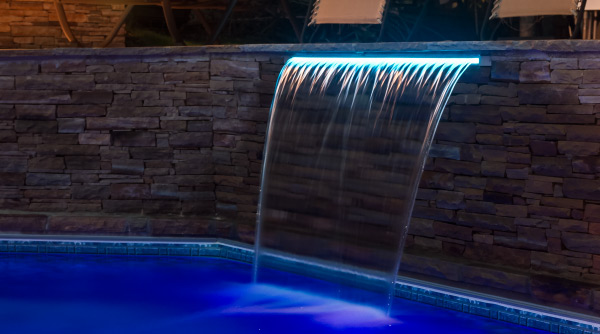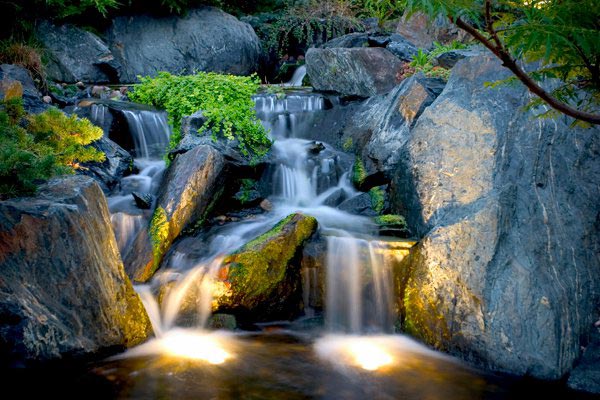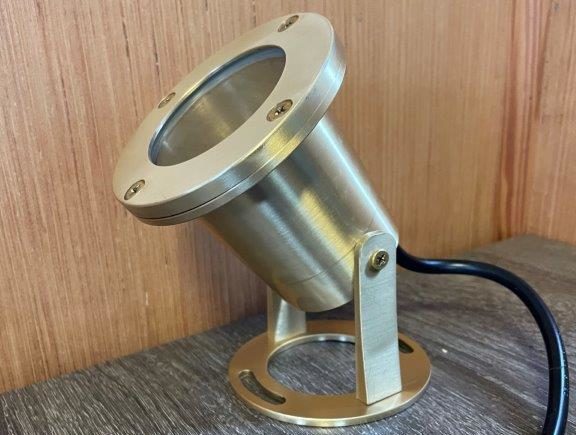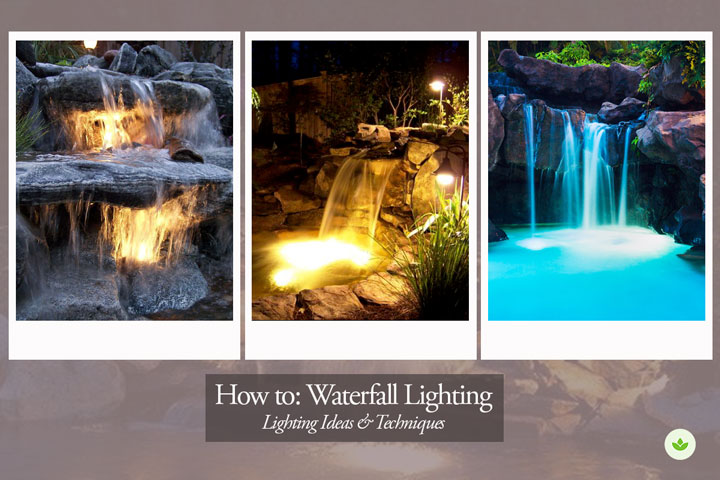Nestled behind a cascading waterfall, a spot or wash light can create a mesmerizing ambiance, casting a firey dance of light. Whether the water tumbles over a rocky precipice, flows gently over a metal chute, or cascades down a machined slate, the enchanting sparkle of a waterfall demand nighttime illumination.
Waterfalls come in various heights and widths. Some water features have a single natural fall while others have several falls of varying sizes. With multiple waterfalls, it is essential to decide whether to light them all and, if not, which ones should be lit to create a balanced lighting scheme.
You can illuminate the waterfall from below, the side, or the front. Submerged lights placed behind the cascading waters create a subtle glow from the depth of the water basin while concealing the fixture in the foaming water. When lighting from the side or front, focus on the area where the water descends into the pool to capture the peak of drama and motion. It is best to avoid lighting the fall from behind, as it may direct unwanted glare toward primary viewing points.
The lights should be included as part of the scene from the outset. Adding to an existing installation will be less straightforward.
Types of Waterfalls
Break down the waterfall into three main areas: the top, cascading water, and the surface where the waterfall lands. Focus your lights based on the type of waterfall you have, considering whether it’s rocky, multi-level, or laminar-flow style.
A key characteristic to consider is the type of weir used. The weir is the edge that the water falls over when making a descent. This can be;
- Smooth fall
- Rough fall
Smooth Fall:
When water flows over a smooth weir, it drops as a wide sheet of water without air bubbles. To enhance its beauty, consider backlighting it by placing a strip of light or puck light underneath the lip of the ledge. LED strips can be twisted, wound, and coiled into various shapes and are easy to install beneath ledges.
Alternatively, you can position a fixture in front of the falling for a sparkling effect on the water’s surface. Aim to catch the water and create a combination of glass-like smoothness on top and agitation at the bottom. The light reflects off the water and provides some backlighting.
This is similar to wall washing with the light passing through the flowing water to illuminate the area behind it. The fixture is placed far enough in the front so its beam spread covers the height of the fall. If using two fixtures, position them close together to ensure their beam spreads overlap.
However, when lighting from the front, be cautious of potential glare caused by light bouncing off the water at an angle.

Sheet Waterfall lit with a strip light installed at the ledge
Rough Fall:
When dealing with a rough weir, the water movement introduces air bubbles, creating a foaming effect. To accentuate this, use uplights positioned underneath the water to create a beautiful glow as the light interacts with the air bubbles.
The ideal fixture location depends on the speed of the water flow. Faster-moving water tends to land farther out than slow-moving water.
Place the fixtures precisely where the falling water hits the water’s surface so that the light travels from the basin up into the falling water, creating a captivating effect. If the fixture is positioned too far in front or behind the falling water, the light won’t be absorbed by the fall.
To create the illusion of a rock grotto with a sparkling curtain in front, consider moving the luminaire slightly behind the cascade, especially if there is an interesting rock formation behind the waterfall.
Wispy Waterfall
Lighting a wispy waterfall, such as you get in many ornamental fountains, is a trickier business. The lights must be aimed so that the water appears white against a shadowed background. If the background is also bright, the water is barely visible.
If you have a broken fall or a number of smaller falls, try dotting it with sparkle lights. Tiny, low-voltage luminaires are available that are intended for underwater installations and these are excellent for adding sparkle. Be sure the lumen output is appropriate to the scale of the water feature.

Natural Vs Artificial waterfall
- Natural Fall: To illuminate a natural or natural-looking waterfall effectively, use appropriately sized spotlights concealed so the light source remains hidden. Focus the light precisely to capture the sparkling and splashing water.
- Artificial Fall: Artificial falls provide more creative freedom. You can experiment with colors and lighting effects that might not be suitable for a natural waterfall.
Light Placement
When it comes to fixture placement, you have two main options;
- Underwater lighting using submerged lights
- Exterior lighting– This includes downlighting from above and uplight from below but above the water surface.
Combining exterior and submerged lighting for the best results.
Submersible lighting
To showcase the enchanting display of froth, bubbles, and water flow in a waterfall, the best approach is to illuminate it from beneath the water’s surface. Fast-moving water generates air bubbles, and when light passes through them, it scatters, producing a dramatic shimmer effect and creating a captivating glow along ledges and beneath rocks.
The type of waterfall will influence the positioning of the underwater lights. Experimentation is essential to determine the optimal placement of the submerged fixtures because water can bend and refract light.
In cases where rock gardens accompany the waterfall, they may form the backdrop of the focal point. To avoid casting upper rocks and plantings into complete shadow, additional spotlights can be placed around the lower pool and sides of the rock feature. These secondary lights provide infill lighting for areas cast into shadow by the underwater fixtures or serve to light up other elements.

In this Image: Notice how the underwater lights are installed to catch the two main falls. The fixtures also cast a gentle flow of shimmering light on the surrounding rocks
Underwater fixture selection
When selecting submersible lights, consider the height of the fall. Flood lamps are typically used to provide width. But as the height of the fall increases, a narrower beam spread with a more vertical throw may be more suitable.
The lights can be fixed mounted or angled. Angled fixtures allow for added flexibility. Fixtures need to have strong locking mechanisms, such as yoke locks, to maintain the desired aiming angle due to the force of water-not just under falls, but wherever there is a current or steady movement of water. Submersible luminaires should be fully water-protected (IP 68 rated) and UV protected.
Colored lights can enhance the appearance of the bubbles offering the flexibility to shift from a serene to a lively atmosphere. Color-changing features can be used for special events, holidays, and parties, providing an enjoyable experience for everyone, especially children.
Opt for fixtures that sit on the pool bottom rather than those recessed into it, as this allows for flexible placement after the fall installation. However, keep in mind that these fixtures may be visible if the waterfall does not flow continually.

Underwater brass fixture
Installation
Ensure that underwater fixtures are securely mounted on brackets and supports that can withstand water turbulence. These supports should also be adjustable to allow for optimal positioning and ease of maintenance, including lamp replacement and cleaning.
Maintain a clean and seamless look without visible wires. This can be achieved by running a water conduit into the pool’s bottom and using an extra sleeve to connect it to power in a dry area.
Utilize underwater lights with long leads, which can be routed through the conduit. There should be enough lead to allow for easy access to the fixture for servicing.
Exterior lighting
Strategically placing wide-beam downlights from an elevated position like a nearby mature tree can gently wash light over the running while spilling to the surrounding foliage and landscape features. This showcases the streaming water while casting mesmerizing reflections on the pond or pool surface.
Additionally, you can conceal small fixtures, well lights, or rock lights among the plants along the edges of the brook to highlight them at night. This adds intriguing shadows to the waterfall and pond adding depth and dimension to the lighting scheme.
Waterfall & Pond lighting options
There are several options available for pool waterfall lights, including:
- Low Voltage LED Lighting: LED lights are energy-efficient, consume less electricity, and boast an impressive lifespan compared to traditional incandescent lights. Users can choose between white lights and color-changing RGB lights based on personal preferences. RGB and RGBW options provide the freedom to select colors and customize the lighting scheme.
- Solar Lights: Affordable and eco-friendly, solar lights like floating lily pads eliminate the need for complex installations and wiring. They harness solar energy during the day to illuminate the waterfall at night, offering an environmentally conscious lighting solution.
- Fiber Optics: This option allows for easy customizations and removes the need for electrical connections in the water. Fiber optic lights can be tailored to create various lighting effects, enhancing the visual appeal of the waterfall.
Remember to control your lights’ operation hours to conserve energy and extend their lifespan.


